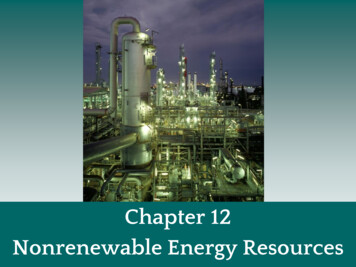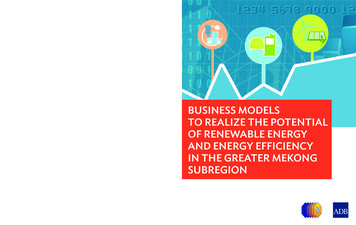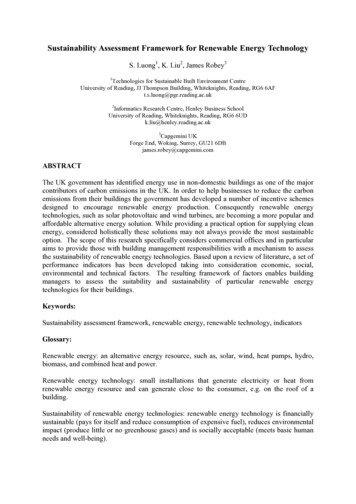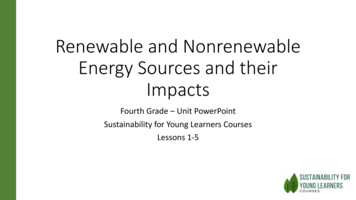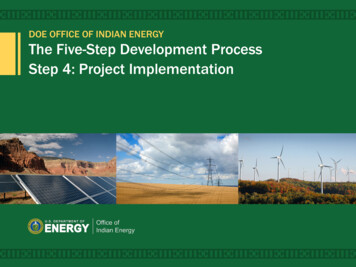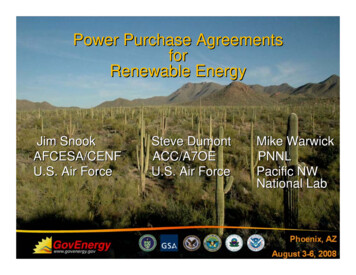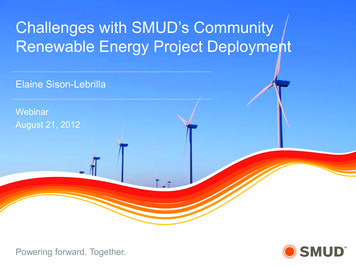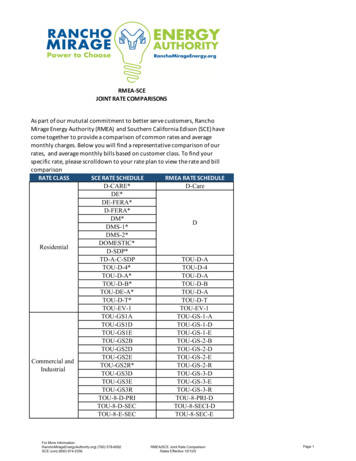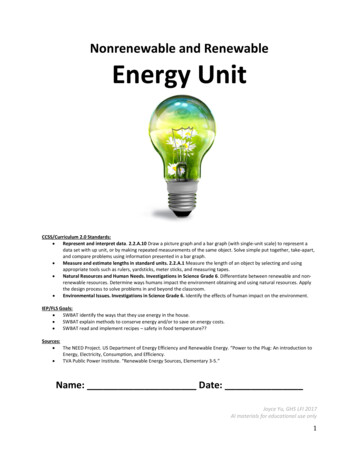
Transcription
Nonrenewable and RenewableEnergy UnitCCSS/Curriculum 2.0 Standards: Represent and interpret data. 2.2.A.10 Draw a picture graph and a bar graph (with single-unit scale) to represent adata set with up unit, or by making repeated measurements of the same object. Solve simple put together, take-apart,and compare problems using information presented in a bar graph. Measure and estimate lengths in standard units. 2.2.A.1 Measure the length of an object by selecting and usingappropriate tools such as rulers, yardsticks, meter sticks, and measuring tapes. Natural Resources and Human Needs. Investigations in Science Grade 6. Differentiate between renewable and nonrenewable resources. Determine ways humans impact the environment obtaining and using natural resources. Applythe design process to solve problems in and beyond the classroom. Environmental Issues. Investigations in Science Grade 6. Identify the effects of human impact on the environment.IEP/FLS Goals: SWBAT identify the ways that they use energy in the house. SWBAT explain methods to conserve energy and/or to save on energy costs. SWBAT read and implement recipes – safety in food temperature?Sources: The NEED Project. US Department of Energy Efficiency and Renewable Energy. “Power to the Plug: An introduction toEnergy, Electricity, Consumption, and Efficiency. TVA Public Power Institute. “Renewable Energy Sources, Elementary 3-5.”Name: Date:Joyce Yu, GHS LFI 2017Al materials for educational use only1
What is Energy?Energy makes things change. Scientists define energy asthe ability to do work. Energy moves cars along the road andboats over the water. It bakes a cake in the oven and keeps icefrozen in the freezer. It plays our favorite songs on the radioand lights our homes. Energy helps plants to grow. Energymakes our bodies grow and allows our minds to think.Directions: Draw 3 examples of things that need energy.1.2.3.We have to get our energy from an energy source. An energy source issomething that can produce, or make, energy. You need a source to createelectricity to power your lamp or your oven. You need a source to create the gasyou put in your car. There are 2 types of energy sources: renewable andnonrenewable.2
Nonrenewable Energy SourcesAn energy source is nonrenewable when youcannot get more of the energy source after you useit, or that it is very hard to get more of it. Anonrenewable energy source is limited. Someexamples of nonrenewable energy sources are coal,petroleum, and natural gas. We use these to makeelectricity, power our cars, heat our homes, and makeproducts.Vocabulary WordDefinitionNonrenewable EnergySourceExample #1Example #2Example #33
It takes millions of years to form petroleum (also known as crude oil). Read thediagram below to find out how it is made.After the petroleum is extracted from underground, you can’t use it right away forenergy. The petroleum is sent to a factory in order to be turned into gasoline orother products. This process is called oil refinery.Drilling for petroleum underseaRefinery factoryThe gas we put in our carsWhy do you think petroleum is a nonrenewable resource?4
Directions: Read the following graph. Use the graph to answer the question below.Which two states produce the most crude oil (petroleum) in the United States?5
Impact of Using Nonrenewable Energy SourcesNonrenewable energy sources, such as coal or natural gas, are used morebecause they are cheaper and easier to use. However, using these nonrenewableenergy sources to create electricity pollutes the environment. Air pollution canlead to breathing problems, heart attacks, and cancer. Carbon dioxide emissionsalso trap heat on Earth and make the planet’s temperature go up, which greatlyaffects our health, environment,and climate.Using nonrenewable energy sources can also harm the environment whenwe extract the sources. For example, drilling for petroleum in the ocean destroysoceanic habitats.Sometimes, the shipsholding the oil may leak,which also kills animalsthat live in the ocean.How does using nonrenewable energy sources impact the environment?6
Renewable Energy SourcesAn energy source is renewable when you canget you get more of the energy source. It will renewitself. Some examples of renewable energy sources arehydropower, solar energy, and wind energy. Wemostly use these to make electricity.Vocabulary WordDefinitionRenewable Energy SourceExample #1Example #2Example #37
Impact of Using Renewable Energy SourcesMost renewable energy sources, like wind or water, produce very littlepollution. This can reduce sicknesses that people get from breathing in airpollution. In addition, gettingrenewable energy sources does notharm the environment. You don’thave to dig up the land to get sunenergy or wind energy. Most ofall, it will continue to renew itself.There will always be windblowing and there will always besun shining, so we can continueto use its energy.Would you encourage people to use nonrenewable energy sources or renewableenergy sources? Explain why or why not.8
Directions: Read the following graph. Use the graph to answer the question below.1. Which type of energy was the most used in the United States in 2014?2. Which type of energy was the least used in the United States in 2014?3. Out of the energy use in the Untied States, what percent was nonrenewable energy?4. Out of the energy use in the Untied States, what percent was renewable energy?9
Directions: Based on what you have learned so far, fill in the chart!Nonrenewable EnergyRenewable EnergyDefinition:Definition:Examples:Examples:One reason we should use LESS:One reason we should use MORE:10
Using Solar EnergyWe can capture sunlight anduse its energy for many differentthings. In the U.S., people use solarenergy mostly to heat buildings andwater and to generate electricity. Insome countries, many people usesolar energy to cook food by buildingsolar cookers.11
How Do Solar Cookers Work?Directions: Read about 3 ways solar cookers work with the sun’s energy. In each diagram, followthe directions to color or label it.1) Solar cookers concentrate sunlight. A mirror or shiny foil reflects the rays of thesun. Color the foil on the flap gray. Draw the sun’s rays reflecting off of the foil.2) Solar cookers turn light into heat. The black paper absorbs the rays and heat ofthe sun. Color the inside of the box black. Draw the sun’s rays being absorbed.3) Solar cookers trap heat. The black paper and the plastic keep the hot air insidethe solar cooker so it can’t escape. Color the plastic blue. Draw the sun’s rays beingtrapped inside.12
SOLAR COOKER MODEL PROJECTPeriod 1Period 2Pizza box ovenPringles ovenTrifold ovenReflective solar ------------------Directions: Cut out pictures to paste into vocabulary boxes:13
Solar EnergyThe sun is a star and a giant ball of gas. It sends out huge amounts of energyevery day. Most of the energy goes off into space. Only a small part reaches theEarth, but this amount is large enough to provide energy for many things!The sun provides a limitless, nonpolluting, free source of energy for theearth. Plants need to have sunlight inorder to live. Throughphotosynthesis, plants give offoxygen, which we need in order tolive! We also need the sun’s heat andlight in order to survive on earth. Ifthere were no sun, we would allfreeze to v14
Big Ideas What is energy?What do you use energy for in your house?Sources of energyo Renewable vs. nonrenewable energyo Benefits of renewable energySolar energyo What can you use it for?o How it works – what you needo Application – solar cooker, solar water heaterEnergy conservationVocabulary n15
1 Nonrenewable and Renewable Energy Unit CCSS/Curriculum 2.0 Standards: Represent and interpret data.2.2.A.10 Draw a picture graph and a bar graph (with single-unit scale) to represent a data set with up unit, or by making repeated measurements of the same object.

